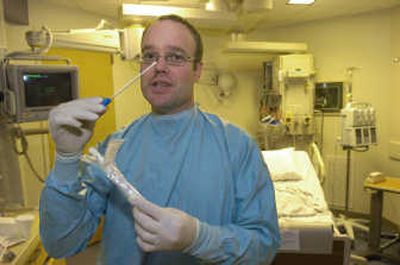Screening for a superbug

A new nasal screening program in Sacred Heart Medical Center’s busiest intensive care unit may already have prevented transmission of a potentially deadly “superbug.”
One of 24 patients admitted to the unit last week was found to be colonized with MRSA – Methicillin-resistant Staphylococcus aureus – the increasingly common germ that defies frontline antibiotics.
Although the patient didn’t have an active infection, he was isolated to stop the spread of the bug to others.
“That patient could have gone through their whole stay without anyone knowing,” said Mary Jo Moore, the nurse who runs the adult trauma ICU at the Spokane hospital. “That’s one patient that we knew about.”
Another patient with a known history of MRSA also was isolated in a room where workers and visitors were required to wear gowns and gloves, Moore said.
Decreasing the number of patients who develop dangerous drug-resistant infections during hospital stays is the point of the small pilot project launched this month by Sacred Heart, one of a few hospitals in Washington and across the country to launch targeted MRSA screening.
It’s also the goal of a new protocol required at the Veterans Affairs Medical Center in Spokane and elsewhere.
At Sacred Heart, nurses will swab the nasal passages of every person admitted to or transferred from the ICU. At the VA, workers have started screening every patient admitted, transferred or discharged, said nurse Jan Palmer, who’s in charge of infection control.
Organizers in both locations are using a faster, cheaper new test that can determine within a day which patients carry MRSA in their nasal cavities. That information will be used to protect other patients and also to determine how widespread the drug-resistance actually is.
Previous analysis estimated that about half of all Staphylococcus cultures conducted by Spokane’s Pathology Associates Medical Laboratories were drug-resistant.
“For Spokane, this is cutting edge,” said Roy Almeida, Sacred Heart’s director of epidemiology.
But for patients infected with MRSA and their families, the screenings are too little, too late.
“I don’t know what to tell you other than to say it’s about time,” said Ron Geisbush, 49, of Spokane.
His 85-year-old mother, Louise Geisbush, developed a MRSA infection in an artificial knee after going to a local rehabilitation center to recover from a fall that left her with a head injury. The head injury has long since healed, but the MRSA threatened her life, her son said. High-powered intravenous antibiotics appear to have knocked down the infection for now.
“We’ll have to wait and see if it comes back,” said Ron Geisbush, a stagehand at the INB Performing Arts Center. “From what I’ve heard about MRSA, they’ve taken too long to start screening.”
That contention is at the heart of a national medical debate over screening for MRSA and other hospital-acquired infections. About one in every 22 patients acquires an infection while hospitalized, according to the federal Centers for Disease Control and Prevention. That’s about 1.7 million infections a year that result in nearly 100,000 deaths, usually from otherwise routine procedures.
Each infection costs hospitals an estimated $5,000 per patient, and patients nearly $9,000 in direct expenses, according to the Association for Professionals in Infection Control and Epidemiology.
The CDC has estimated annual costs at $5 billion to $6 billion, but other estimates place the price tag much higher.
In the past, most hospitals have relied upon standard infection control protocols to contain infections. Recently, however, some states have passed laws requiring reporting of hospital infection rates, including MRSA. Nineteen states, including Washington but not Idaho, now have laws requiring public reporting of infections. Five states have laws that specifically target MRSA.
Early reports have indicated that screening for MRSA, combined with aggressive infection control practices, have dramatically reduced infections. At the Veterans Affairs hospital in Pittsburgh, the infection rate in one surgical unit dropped by nearly 80 percent after screening began.
It’s far too early to estimate what the results might be in Spokane or elsewhere in Washington. A few hospitals on the West Side have started targeted screening in high-risk ICU patients, said Dr. Estella E. Whimbey, medical director of health care epidemiology and infection control at the University of Washington Medical Center.
Most hospitals continue to rely on strict infection control regimes to prevent transmission of MRSA and other organisms rather than screening to detect them, she said.
“You view every patient as potentially infectious,” said Whimbey.
Soon, however, that approach may not be enough. Next year, Medicare will implement payment plans that penalize hospitals for certain infections and other problems that affect patients after admission. Hospitals could soon regard the expense of screening and isolation as a form of self-defense, said Sacred Heart’s Almeida.
“If you can avert an infection, what’s the cost-benefit of that?” he said. “An infection could cost the hospital tens of thousands of dollars.”
And there’s the human cost as well, said Ron Geisbush, who notes that MRSA is more widespread than HIV and AIDS.
“Not enough is being communicated about how bad MRSA is and how prevalent it is,” he said.